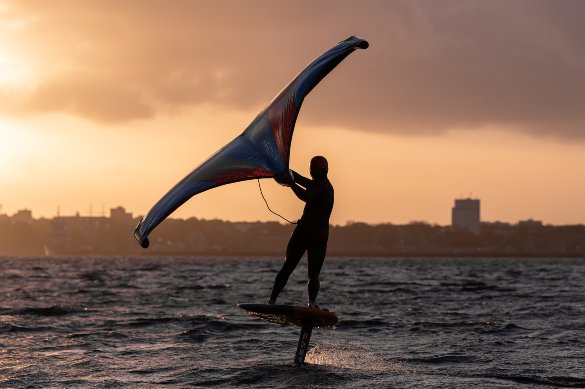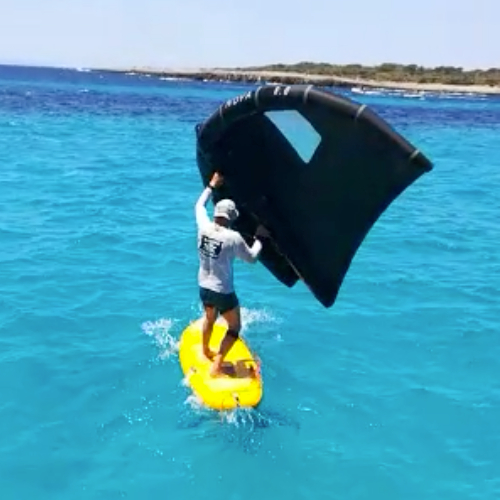
How to take off.
Wingfoiling has become an enormously popular sport.
Learning how to take off and start to fly your board is the hardest part of wingfoiling. It’s probably not what you will be doing on your first session. But once you got it, the rewards are awesome. There are few sports in the world that will give you that same feeling of freedom, speed, manoeuvrability and pure joy.
Read on and find out how to get on the foil and in the air!

How to take off
Learn how to take off: first steps
Before learning how to get on the foil, it’s important to practice wing handling on the beach. The reason is that if you know how to do that, you can focus on getting on the foil now and no energy is spent in fighting the wing. See more tips for absolute beginners in the wingfoil beginners guide.
In wingfoiling, the process of getting out of the water and making the board ride on the foil is called “take-off” and so the process of learning is called how to take off. Once you are completely out of the water and experiencing the thrill of flying above the water, it’s called “flight”. Flying – or “being on the foil” – is one of the coolest feelings out there. Once you make longer flights, you can go to the next level which is to learn how to jibe in the air. That’s when the endless sessions start. But don’t rush: some riders take over a year to get there.
Let’s take a look at the basics of how to get on your first flight or learn everything you need to know about learning to fly in wingfoil.

Sit on the board and let the wing fly
It’s a good idea to start off by just sitting on the board and let your wing fly. You can do this by grabbing the wing from the central handle and see how it “feathers” in the air. Move your hand and notice what happens!
If you move the wing to the front or back of your board, you will notice the board turns with it. This is how you control your position towards the wind.
You wan to start off with your back towards the wind.
Grab the wing with both hands and start sailing
Now use your free hand to grab the far end of the strut of the wing. The more distance there is between both hands, the more power there is in the wing. Use this moment to learn how to sail, how the wing responds to your arms and your board.
Change the way you position your upperbody, your arms and your board and learn how it all works together. This all may seem useless but it helps a lot to build up muscle memory. Everything you learn now you don’t need to pay attention to when trying to take off later.


Get one leg up
Now try to get one leg up and set in a lunge position. This may be tricky in the beginning. Give it a couple of tries and keep going!
Once you have this mastered, we can go on to the next step: getting out of the water and learning how to fly your wingfoil set!
Now we are ready to take off!

Again: start on your knees or on one knee
You already know how to do this, so it should not be hard. Sit on the board on one or two knees, turn your back towards the wind and grab the wing with two hands.
Notice the board starts moving and go to the next step: standing up.
Taxiing: stand up and speed up
As soon as you stand up you can get more speed in the board. The more you pull on the back hand, the more power you get in the wing and the more speed you get on the water.
Make sure your feet are in the centre of the board! The flatter the board is on the water surface, the sooner it starts to pick up speed and fly.


How to take off – getting on the foil
When learning how to fly in wingfoiling, this is the trickiest part. Make sure you speed up enough by either going downwind a bit (not too much) or by pumping.
Once you have notice you are going fast, the board may start climbing out of the water by itself. If it doesn’t, try lifting your weight off your front foot a bit, by moving it to the back foot.
As soon as you know how to take off and you are out of the water, you will notice less sound and more speed.
How to take off: stabilising flight
As said, once you’re out of the water, you will notice silence and an increase in speed. This has to do with the fact that your board meets no more resistence from the water.
If order to stabilise your flight, keep pressure on your front foot so the board stops climbing and it takes on a horizontal position. Keep your speed under control by de-powering the wing.
Read more about how to keep flying.

Wingfoil tutorial: how to take off – see the full video here
And see another video below.
Learn to get on the foil: common mistakes
Here’s a couple of common errors you may commit when learning how to fly in wingfoiling. They are pointed out as a reference, and mainly since we all make them.

Leaning backwards too much
Especially if you come from windsurfing, you are used to leaning backwards as soon as you notice power in the wing.
What will happen is your board will turn upwind and you will end up falling backwards. Try to stay standing up and in the centre of the board. The only time you need to lean backwards is if you actually want to go upwind.
The solution: keep your body in a straight line
The mast and your body should be in a straight line. This means that your weight is distributed in the best way to fly.


Too much weight on the back foot
In order to take off and get on the foil, you need to release a bit of weight from your front foot and place the weight on your back foot.
However, once you’re out of the water and flying, your board wants to keep climbing. That’s more or less like the picture you see here. The risk is that your foil breaches out of the water and you will fall.
Avoid this by pressing the front of the board down with your front foot. If you notice that you have to use a lot of force, try to move your back foot forward on the board.
Not standing straight
This happens to many riders starting to wing foil. If you try to learn how to fly, you get tense from the new sensations of altitude and speed. This makes your body tense and it creates a forced position.
Try to relax while trying how to take off. The more you stand straight, the better you will fly and the better you will ride.


Don’t get frustrated about falling.
We have all been there.
Understanding the dynamics of flying
When wingfoiling, the sensation of flying is created through the combination of wind power, hydrofoil technology, and the design of the wing itself. As a part of learning how to take off it’s good to read this. Here’s an explanation of how wingfoiling allows you to “fly” above the water:
- Handheld Wing: The handheld wing used in wingfoiling acts as a sail or kite. It consists of a rigid framework with a canopy made of lightweight materials such as nylon or Dacron. The wing’s unique design allows it to generate lift when caught by the wind.
- Wind Power: The wind is the primary source of power in wingfoiling. By positioning the wing at the correct angle to the wind and applying tension on the wing, the rider can harness the wind’s force. As the wind pushes against the wing’s surface area, it generates lift, similar to how an airplane wing creates lift to stay airborne.
- Hydrofoil Technology: The hydrofoil is a key component that enables the “flying” sensation in wingfoiling. It consists of a long mast attached to the underside of the board, with a specialized wing-shaped foil at the bottom. When the board reaches a certain speed and the foil is submerged in the water, hydrodynamic forces come into play.
- Lift and Reduced Drag: As the wing generates lift and the board gains speed, the hydrofoil creates lift of its own. The hydrofoil’s wing shape and angle of attack generate upward lift, counteracting the downward force of gravity. This lift effectively lifts the board out of the water, reducing drag and allowing the rider to glide above the water’s surface.
- Balance and Control: Maintaining balance and control is essential in wingfoiling. By shifting body weight and adjusting the wing’s position, the rider can control the amount of lift and speed. Balancing weight distribution on the board and using subtle adjustments with the wing allows for precise control over direction and maneuvering.
By combining the lift generated by the wing with the lift generated by the hydrofoil, wingfoilers are able to glide smoothly above the water, creating a sensation akin to flight. It’s the harmonious interaction of wind power, hydrofoil technology, and the rider’s skill that makes wingfoiling such an exhilarating and unique experience, where the boundary between water and air blurs, and the freedom of flight becomes a reality.
